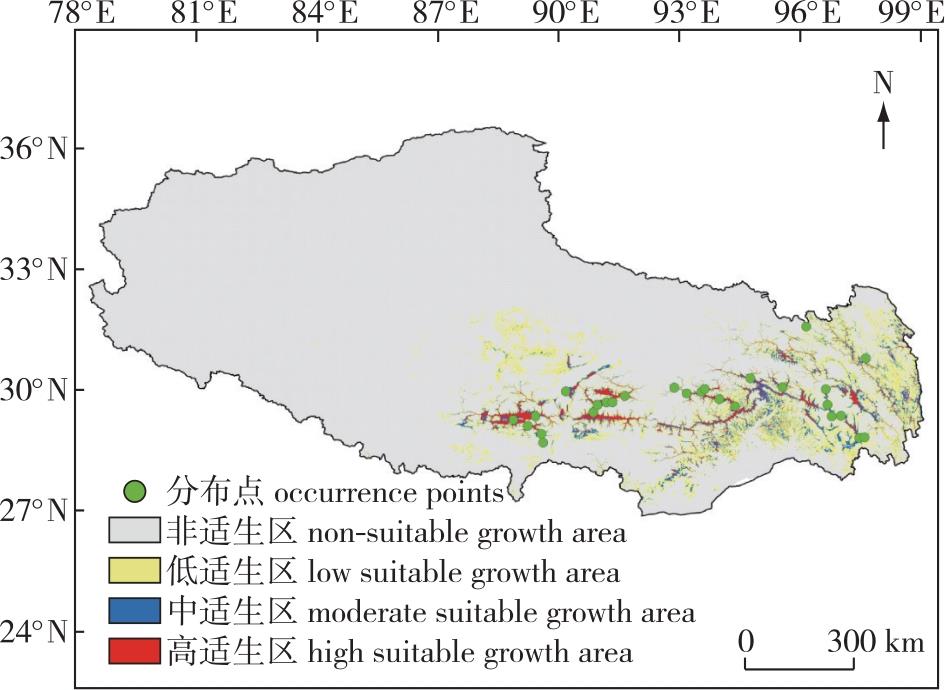 PDF(2421 KB)
PDF(2421 KB)


西藏河谷特有植物小花水柏枝潜在地理分布及环境影响因子
王俊伟, 德吉, 卫波宁, 常子惠, 拉琼
南京林业大学学报(自然科学版) ›› 2025, Vol. 49 ›› Issue (3) : 220-226.
 PDF(2421 KB)
PDF(2421 KB)
 PDF(2421 KB)
PDF(2421 KB)
西藏河谷特有植物小花水柏枝潜在地理分布及环境影响因子
Potential geographical distribution and leading environmental factors of Myricaria wardii, an endemic species of the Xizang river valleys
【目的】小花水柏枝(Myricaria wardii)为柽柳科水柏枝属直立灌木,是西藏河漫滩沙地特有植物,具有重要的生态与经济价值。分析当前和未来(2050s、2070s)潜在地理分布情况及主导环境因子,以期为小花水柏枝的科学保护和合理开发利用提供理论参考。【方法】通过野外调查获得小花水柏枝27个实际地理分布点数据,基于9个环境变量,借助MaxEnt模型和ArcGIS软件对其在西藏不同时期不同气候情景下的潜在适宜分布区进行预测及面积计算,探究影响小花水柏枝自然分布的主导环境因子。【结果】当前小花水柏枝主要集中分布在年楚河流域、拉萨河流域、尼洋河流域、帕隆藏布流域。MaxEnt模型预测结果表现良好,AUC平均值为0.953。最暖季降水量(Bio18)、气温季节性变动系数(Bio4)、最冷月最低温(Bio6)、最冷季降水量(Bio19)、坡度(Slo)对模型的贡献率累计达88.2%,是影响小花水柏枝分布的主要环境变量。2种碳排放浓度下(RCP 4.5、RCP 8.5)小花水柏枝各适生等级的潜在分布区面积均在增加,最大碳排放浓度下(RCP 8.5) 小花水柏枝的潜在适生区扩散速度更快。与当前潜在分布区相比,小花水柏枝分布中心主要沿着西藏各大江河流域呈东南向西北扩散的趋势。【结论】MaxEnt模型可以比较准确地预测小花水柏枝的潜在适生区,西藏中部的年楚河流域、拉萨河流域,东南部的尼洋河流域、帕隆藏布流域为集中分布区域。随着气候变暖的加剧,适生区面积不断扩大,分布中心呈东南向西北方向迁移扩散。
【Objective】Myricaria wardii is an erect shrub of the genus Myricaria in the family Tamaricaceae, endemic to the sandy areas of Xizang rivers and beaches, and has important ecological and economic values. The potential geographical distribution and dominant environmental factors of M. wardii at present and in the future (2050s, 2070s) were predicted and analyzed to provide theoretical references for scientific conservation and rational exploitation of M. wardii.【Method】27 actual geographical distribution points of M. wardii were obtained through field surveys, and the potential suitable distribution areas of M. wardii in Xizang under different climatic scenarios at different times were predicted and the area was calculated with MaxEnt model and ArcGIS softwares to explore the dominant environmental factors affecting the natural distribution of M. wardii.【Result】The MaxEnt model predicted very good results with a mean AUC of 0.953. Currently, the M. wardii are mainly distributed in the Nianchu River Basin, Lhasa River Basin, Niyang River Basin and Parlung Zangbo River Basin. Precipitation of the warmest quarter (Bio18), temperature seasonality (Bio4), min temperature of the coldest month (Bio6), precipitation of the coldest quarter (Bio19), and slope (Slo) contributed 88.2% cumulatively to the model and were the main environmental variables influencing the distribution of M. wardii. The potential distribution area of M. wardii for each fitness class increased at two carbon emission concentrations (RCP 4.5, RCP 8.5), and the potential fitness area of M. wardii spread faster at the maximum carbon emission concentration (RCP 8.5). Compared with the current potential distribution area, the distribution centers of M. wardii mainly spread southeast to northwest along the major river basins in Xizang.【Conclusion】The MaxEnt model can accurately predict the potential suitable areas for M. wardii, with the Nianchu River Basin and Lhasa River basin in central Xizang; and the Niyang River basin and Parlung Zangbo River basin in southeast Xizang as the concentrated distribution areas. With the intensification of climate warming, the area of the suitable areas is expanding, and the distribution center is moving and spreading in a southeast to northwest direction.

小花水柏枝 / MaxEnt模型 / 环境因子 / 地理分布
Myricaria wardii / MaxEnt / environmental factor / geographical distribution
| [1] |
中国科学院中国植物志编辑委员会. 中国植物志-第六十九卷[M]. 北京: 科学出版社,1990.
Editorial Committee of Flora of China. Chinese Academy of Sciences. Flora of China-Volume 69[M]. Beijing: Science Press,1990.
|
| [2] |
郑维列. 西藏色季拉山野生观赏树木资源及其开发利用[J]. 自然资源学报, 1996, 11(1):89-98.
|
| [3] |
王勇, 刘义飞, 刘松柏, 等. 中国水柏枝属植物的地理分布、濒危状况及其保育策略[J]. 武汉植物学研究, 2006, 24(5):455-463.
|
| [4] |
杨小林, 赵垦田, 马和平, 等. 拉萨半干旱河谷地带的植被数量生态研究[J]. 林业科学, 2010, 46(10):15-22.
|
| [5] |
喇晓琴, 张颖君, 曾阳. 水柏枝属植物的化学成分及生物活性研究进展[J]. 青海师范大学学报(自然科学版), 2010, 26(4):52-56.
|
| [6] |
武鑫玥, 易欢, 李红颖, 等. 藏药水柏枝的本草考证及使用现状调查[J]. 成都中医药大学学报, 2022, 45(2):92-98.
|
| [7] |
李莎, 莫舜华, 胡兴华, 等. 基于MaxEnt和ArcGIS预测濒危植物资源冷杉潜在适生区分析[J]. 生态学杂志, 2024, 43 (2):533-541.
|
| [8] |
卫波宁, 常子惠, 张永娟, 等. 雅鲁藏布江三大支流流域小花水柏枝种群结构及动态特征[J]. 生态学报, 2022, 42(24):10241-10252.
|
| [9] |
|
| [10] |
吴显坤, 南程慧, 汤庚国, 等. 气候变化对浙江楠潜在分布范围及空间格局的影响[J]. 南京林业大学学报(自然科学版), 2016, 40(6):85-91.
|
| [11] |
|
| [12] |
|
| [13] |
吴征镒. 西藏植物志[M]. 北京: 科学出版社,1987.
|
| [14] |
|
| [15] |
董京京, 陈洁, 杨宏, 等. 华中樱桃适生区模拟和生态特征分析[J]. 南京林业大学学报(自然科学版), 2022, 46(3):213-221.
|
| [16] |
杨宏, 董京京, 吴桐, 等. 基于MaxEnt模型的迎春樱桃潜在适生区预测[J]. 南京林业大学学报(自然科学版), 2023, 47(4):131-138.
|
| [17] |
龚茂佳, 王娟, 付小勇, 等. 云南广西蒜头果适生区预测及环境影响因子[J]. 南京林业大学学报(自然科学版), 2022, 46(2):44-52.
|
| [18] |
|
| [19] |
|
| [20] |
|
| [21] |
|
| [22] |
|
| [23] |
徐惠珠, 金义兴, 赵子恩, 等. 三峡库区特有植物疏花水柏枝繁殖的初步研究[J]. 长江流域资源与环境, 1999, 8(2):158-161.
|
| [24] |
萧前椿. 西藏高原的自然环境和农业生产[J]. 地理学报, 1954, 9(4):427-449.
|
| [25] |
缪菁, 王勇, 王璐, 等. 基于MaxEnt模型的苦槠潜在地理分布格局变迁预测[J]. 南京林业大学学报(自然科学版), 2021, 45(3):193-198.
|
| [26] |
马青江, 孙操稳, 张乐英, 等. 东亚四照花群体中国潜在适生区预测研究[J]. 南京林业大学学报(自然科学版), 2019, 43(5):135-140.
|
| [27] |
韩淑敏, 闫伟, 杨雪栋, 等. 白榆在我国的潜在分布格局及未来变化[J]. 南京林业大学学报(自然科学版), 2023, 47(3):103-110.
|
| [28] |
王爱君, 路东晔, 张国盛, 等. 基于MaxEnt模拟欧亚大陆气候变化下叉子圆柏的潜在分布[J]. 林业科学, 2021, 57(8):43-55.
|
| [29] |
|
/
| 〈 |
|
〉 |